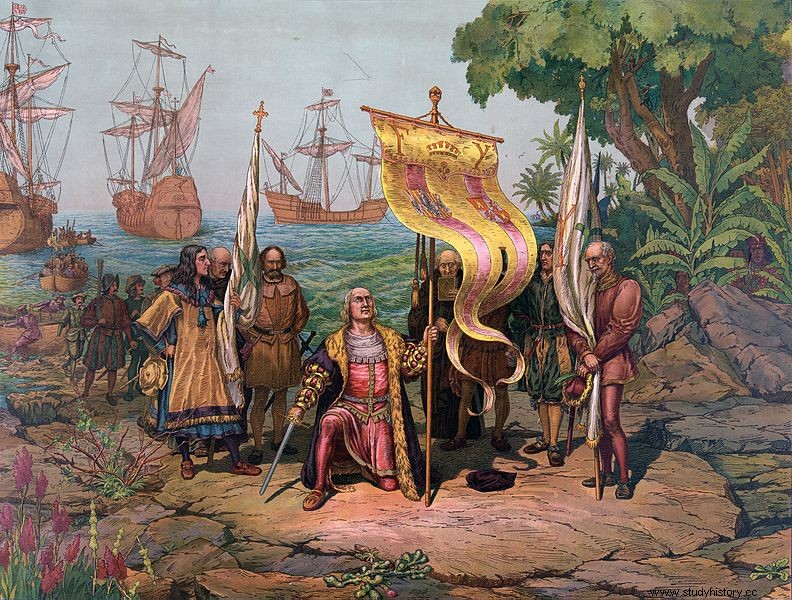- At the end of the 15th th century, maritime explorations and discoveries are multiplying in Africa, and the world is turned towards the discovery of a fantasy Asia.
- Christophe Colomb, a Genoese navigator, was influenced by Ptolemy's Geography:the Earth being round, he thought he could reach the Indies from the west, but did not know the real size of the globe. For years, he tried unsuccessfully to convince the European kings to finance his crazy project. It was only after the capture of Granada in 1492 that the Catholic kings were willing to give him credit, without, however, believing too much in it.
1492 - 1504

Characters
Christopher Columbus
Amerigo Vespucci
Procedure
1492 – 1493
In 1492, Columbus was finally granted the necessary departure, three boats and 90 sailors. Nobody believed in his success, so he was appointed viceroy of the discovered lands.
The fleet set sail on August 3, 1492; in October, she arrives in the Bahamas where she is welcomed by peaceful Indians.
They discover Cuba and Hispaniola (Haiti), but one ship runs aground and they lose another, which delays their departure. Columbus founded the small town of Navidad in Hispaniola and then left on January 4, 1493, leaving a few men in Navidad.
He finds the second boat and arrives in February in Portugal, without gold but sure to have found a new route to India. If in Portugal, the reception of sailors is mixed, a triumphant welcome is given to them in Spain.
1493 – 1496
On September 25, 1493, the largest exploration fleet ever chartered set sail from Spain, led by Columbus. It has 17 ships and more than 1,200 men.
At the beginning of November, they discover Dominica, Marie-Galante and Guadeloupe, this time with clashes with the natives.
Back in Navidad, Columbus discovers that his small colony has been exterminated after abusing the natives; retaliation is cruel.
In January, he founded a new colony, La Isabella, near gold deposits. Columbus is the implacable governor of the colony. The Spaniards quell the indigenous revolt and organize their exploitation. The native population is drastically reduced.
He still thinks he's in India but doesn't understand why he can't find great civilizations. His return in 1496, without gold, was less triumphant:Spain lost a lot of money on this trip and was then at war with France.
1498 – 1500
On March 30, 1498, Christopher Columbus set out again with a small fleet of three ships and discovered the banks of the Orinoco, thinking he was at the gates of earthly paradise.
Back in Haiti, he begins a savage exploitation of the natives, but the dissensions between Spaniards are accentuated.
In 1500, an investigator was sent by the Catholic kings to inspect the colony:Columbus was arrested for having hidden wealth from the crown.
Back in Spain, he is not judged harshly but loses his power as the exploration continues unabated.
1502 – 1504
Columbus' last voyage, after his release, takes a dramatic turn, punctuated by storms and deaths. Columbus discovers this time the American isthmus, but still does not find the route to India. He died in 1506.
Consequences
- These discoveries lead to the Treaty of Tordesillas on June 7, 1494, by which Spain and Portugal share the unknown lands. There followed a whole series of expeditions and an accelerating colonization.
- At the very beginning of the 16th th century, Amerigo Vespucci realizes that Columbus has discovered a new continent. The riches of the latter will build the rich Europe of the Renaissance.
